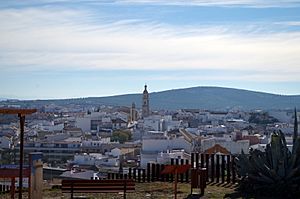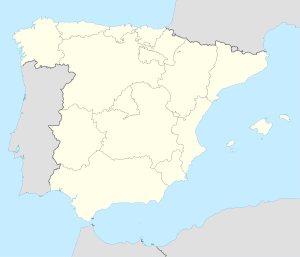Aguilar de la Frontera facts for kids
Quick facts for kids
Aguilar de la Frontera
|
|||
|---|---|---|---|
 |
|||
|
|||

Location of Aguilar de la Frontera in the province of Córdoba.
|
|||
| Country | |||
| Municipality | Córdoba | ||
| Area | |||
| • Total | 166.48 km2 (64.28 sq mi) | ||
| Elevation | 280 m (920 ft) | ||
| Population
(2018)
|
|||
| • Total | 13,438 | ||
| • Density | 80.718/km2 (209.060/sq mi) | ||
| Time zone | UTC+1 (CET) | ||
| • Summer (DST) | UTC+2 (CEST) | ||
| Postal code |
14920
|
||
Aguilar, or its full name Aguilar de la Frontera, is a town and an area (called a municipality) in southern Spain. It's located in the province of Córdoba, in a region called Andalusia.
The town is close to a small river called Cabra. It's about 50 kilometers (31 miles) from Córdoba, which is the capital city of the province. Aguilar de la Frontera is also on the railway line that connects Córdoba and Málaga.
For a long time, Aguilar de la Frontera was known as Ipagro. It was even an important religious center in ancient and medieval times. The town's population has stayed pretty much the same over the last 100 years, with about 13,653 people living there in 2007.
Contents
Discovering Aguilar de la Frontera's Past
Early Beginnings and Roman Times
People have lived in the area around Aguilar de la Frontera for a very long time. The first signs of humans here date back to the middle of the Palaeolithic Age, which was the Old Stone Age.
Later, the Romans took control of the area from the Iberians. This happened during the time of the Roman Republic. The Romans named the town Ipagro.
Ipagro played a part in a civil war between two famous Roman leaders, Julius Caesar and Pompey. The town grew and became important during the early years of the Roman Empire.
From Visigoths to Muslim Rule
After the Western Roman Empire fell, the Visigoths ruled the town. Then, starting in the 8th century, Muslim leaders from the emirate of Córdoba took over. They called the town Bulay or Pulay.
In the 9th century, a rebel leader named Umar ibn Hafsun made Bulay his main base. He built many strong defenses and made the castle even stronger. However, in 891, Umar ibn Hafsun lost the town to emir Abdallah ibn Muhammad of Córdoba.
Because of its important location, many groups wanted to control Bulay. After the large Muslim empire (called the caliphate of Córdoba) broke apart, Bulay became part of the area known as the cora of Cabra.
Christian Conquest and New Name
In 1240, Christian forces conquered the town. Even after the conquest, many Muslims were allowed to stay. King Peter I of Castile gave control of the town to a nobleman named Alfonso Fernandez Coronel.
But later, the king took it back for the crown. The town was then renamed Aguilar of the Frontier. This new name showed its position on the border with the Moorish Kingdom of Granada, which was still under Muslim rule.
Growth and Challenges Over Time
In 1370, King Henry II of Castile gave Aguilar to Gonzalo Fernandez de Cordoba. This was a reward for his loyalty during a civil war. Gonzalo's family controlled the town for many centuries, until a system called feudalism ended in the 1800s.
The town grew steadily until the 1570s and 1580s. After that, its growth slowed down. This was partly because of several outbreaks of the plague, which caused many people to die. Also, farming became less productive.
During the Spanish Civil War (1936-1939), Aguilar de la Frontera supported the Nationalist side. Many people from the town fought and died for this cause.
Exploring Aguilar de la Frontera's Sights
Aguilar de la Frontera has many interesting old buildings and places to see.
- Castillo de Aguilar: This is a castle that has been around since at least the 9th century. Most of it is now in ruins. Part of the castle has been turned into a large tank to hold water for the town's water system.
- Casas seňoriales: These are old "Noble mansions." Some famous ones include the houses of the Moralejo, Arrabal, and Carrera families, built in the 16th and 17th centuries.
- Torre del Reloj: This is a beautiful Clock Tower built in the Baroque style. It was constructed between 1770 and 1774.
- Plaza de San José: This is a unique square built in 1806. It has a polygonal (many-sided) shape and is home to the Ayuntamiento (Town Hall).
- Parish Church of Nuestra Señora del Soterraño: This church was first built in 1260 and then rebuilt in 1530.
- Church of Cristo de la Salud: This church dates back to the 17th century.
- Church of the Candelaria: This church was built in the 16th century.
- Church of Nuestra Sra. del Carmen: Another church from the 16th century.
- Ermita de la Vera Cruz: A small chapel from the 16th century.
- Hospital of Santa Brigida: This hospital was built in the 16th century.
- Convent of San José y San Roque: This convent was built in 1671. It is also known as "Las Descalzas."
Aguilar de la Frontera's Economy
The town of Aguilar de la Frontera is well-known in Spain for its olives and white wine. The wine, which tastes a bit like sherry, is often called Montilla. This is because it comes from the nearby town of Montilla.
There are also salt springs in the area. To the south of the town, you can find two small lakes, Zoñar and Rincon, which have lots of fish.
About 60% of the people in Aguilar de la Frontera work in agriculture at some point during the year. However, farming only makes up about 30% of the town's total economic activity.
Twin Towns
See also
 In Spanish: Aguilar de la Frontera para niños
In Spanish: Aguilar de la Frontera para niños




